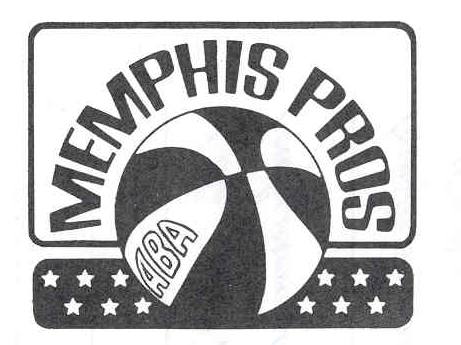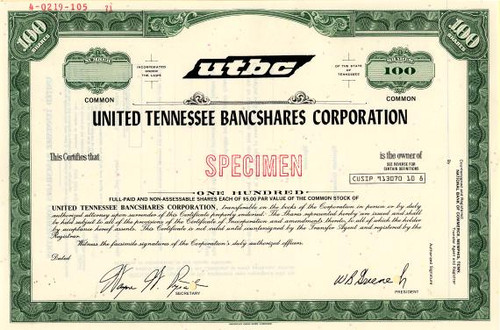Beautifully engraved RARE Specimen Certificate from the Memphis Area Sports, Inc - Memphis Pros printed in 1971. This historic document was printed by the Nothewest Banknote Company in 1971 and has an ornate border around it with a vignette of the team's logo. This item has the printed signatures of the company's officers. This is first time we have seen this certificate. 
Certificate Vignette New Orleans Buccaneers 19671970 The New Orleans Buccaneers were a charter member of the ABA. The Buccaneers were coached by Babe McCarthy, who was famous for two reasons. One was that he had coached Mississippi State University to a Southeastern Conference championship in an era when that league's basketball was dominated by the University of Kentucky. The other was when the then all-white Mississippi state legislature forbade the team to participate in the racially integrated NCAA Tournament. McCarthy took the team out-of-state in the dead of night and had them participate anyway, which gave him a near-legend status in the eyes of some (and the undying hatred of others). Memphis Pros 19701972 On August 21, 1970, the team was sold to Memphis businessman P. W. Blake. Ten days later, he moved the team to Memphis and changed its name to the Memphis Pros, reportedly because the already purchased 'Bucs' uniforms could easily be converted to 'Pros' uniforms at little expense. The Pros had players like Steve "Snapper" Jones , Gerald Govan, Jimmy Jones, and Wendell Ladner and a coach Babe McCarthy. 19701971 season The Pros immediately ran into problems due to the timing of the move. The Mid-South Coliseum was nearly booked solid through the winter, and the Pros were only able to secure one Friday home game. They were forced to play the balance of their home schedule in several other arenas in Tennessee and Mississippi. Not surprisingly, ticket sales slowed to a trickle; by the start of the season they'd only sold 180 season tickets. Bob Warren of the Los Angeles Lakers joined the team, and Ron Franz and Dave Nash were traded to The Floridians for Wilbert Jones, Al Cueto and Erv Staggs; later, Red Robbins was traded to the Utah Stars for Craig Raymond and Skeeter Swift was traded to the Pittsburgh Pipers for Charlie Williams. Jimmy Jones, Steve Jones and Wendell Ladner played in the 1971 ABA All-Star Game; Ladner, a pick in the last ABA draft, also made the ABA All-Rookie team. An average of 3,199 fans attended Pros home games during the season. The Pros finished with 41 wins and 43 losses, which put them in third place in the Eastern Division. The Pros advanced to the playoffs but lost in the Eastern Division semifinals to the Indiana Pacers, 4 games to none. The Pros almost didn't survive that season. In December 1970, Blake simply walked away from the team, claiming to have lost $200,000. The league desperately tried to find a new owner, but there were no takers. Finally in February, a community group, Memphis Area Sports Inc., bought the team for $700,000. It was composed of 4,600 Tennessee residents who bought the team's stock at $5, $10 and $50 a share and elected a 24-person board to run the team. Memphis stockbroker A. Hart was installed as team president. 19711972 season The team signed Johnny Neumann, an underclassman All American from the University of Mississippi, and added Larry Cannon, but lost Steve Jones to the Dallas Chaparrals through free agency; Jimmy Jones also departed, ending up with the Utah Stars. On October 6, 1971 the Pros hosted the NBA's Boston Celtics for a preseason exhibition game. The Celtics won, 115-94. This was the only time a Memphis team played an NBA team until the Vancouver Grizzlies moved to Memphis in 2001, thirty years later. The Pros traded Larry Cannon to the Indiana Pacers in mid-season for Don Sidle, and executed another midseason trade which sent Wendell Ladner, Tom Owens and Bobby Warren to the Carolina Cougars for Randy Denton, Warren Davis and George Lehmann. The latter trade was initiated by Hart without consulting McCarthy. The Pros had one player, Wil Jones, play in the 1972 ABA All-Star Game. Despite (or perhaps because of) all the personnel moves, the team finished with only 26 wins against 58 losses, which put them in fifth (last) place in the Western Division, 34 games behind the Utah Stars, and kept them out of the playoffs. Although they averaged 4,441 fans per home game, the team's financial problems cropped up again, and forcing the league to take control of the team for a second time. On April 27, 1972 Babe McCarthy resigned as the Pros' coach. Memphis Tams 19721975 On June 13, 1972, the team was purchased by Charles O. Finley, who also owned Major League Baseball's Oakland A's and the NHL's California Golden Seals. Finley also took over the team's debts. Legendary former University of Kentucky head coach Adolph Rupp became team president. The winning entry in a "Rename the Team" contest was the Memphis Tams, perhaps one of the few entries that could be said to have been even less likely than "Pros." The nickname was an acronym for Tennessee - Arkansas - Mississippi, and the logo was a tam o'shanter-style hat in white, green and gold, which were also the new team colors, shared with the Athletics and Golden Seals. 19721973 season McCarthy was succeeded by Bob Bass. The Tams landed George Thompson in a dispersal draft of Pittsburgh Condors players. Gerald Govan was traded to the Utah Stars for Merv Jackson. George Thompson played in the ABA All Star game but the Tams finished the season with only 20 wins compared to 64 losses. It was the worst record in the ABA and put them in fifth (last) place in the Eastern Division, 33 games behind the Carolina Cougars. The Tams did not make the playoffs, in part due to heavy roster turnover (they made 28 roster moves in the first two months of the season alone). Despite their poor play they averaged 3,476 fans per home game. Finley had the team wear all possible combinations of green, white and gold tops and trunks. However, he had little to no involvement with franchise operations. Despite his earlier promises, he was already in negotiations with officials in St. Paul, Minnesota to move the team there. When word got out of this, Finley went from savior to pariah almost overnight. He didn't help his own cause by instituting several cost-cutting moves. For instance, he cut one veteran player before Christmas, and another on New Year's Day. 19731974 season The Tams picked up draft picks Larry Kenon and Larry Finch. The Tams also used a draft pick to select underclassman David Thompson but Thompson stayed in college. Finley had asked the ABA to look into his claims that ABA president Bill Daniels had a conflict of interest due to asking Finley to pay him a finder's fee for helping Finley find potential buyers for his team. The ABA declined to investigate Finley's charges. Finley tried to sell the team to a group of investors from Providence, Rhode Island but no sale was forthcoming. For much of the summer, the Tams' status was up in the air. Bass had resigned to take a position with the league, and the team offices had been closed since mid-June. It wasn't until late August that Finley sent word that the Tams would play. In the process, he'd held up almost all of the league's radio and TV contracts. Even then, the team had no coach and virtually no front office when training camp opened in September. Finally, two days before the team's first preseason game, Butch van Breda Kolff was hired as general manager and head coach. The Tams signed Charlie Edge, traded Larry Kenon to the New York Nets for Jim Ard and John Baum and traded Johnny Neumann to the Utah Stars for Glen Combs, Ronnie Robinson, Mike Jackson and cash. George Thompson played in the ABA All Star game but the team had another poor season, finishing with 21 wins and 63 losses--the worst record in all of pro basketball. With their poor play the team's home attendance dropped by about one third from the prior season as the Tams averaged 2,331 fans per home game. This was largely because Finley seemed to lose whatever interest he had in the Tams. He went weeks without communicating with van Breda Kolff about team business or roster moves. He also stopped putting out programs, replacing them with free typed mimeographed lineup sheets. Van Breda Kolff was visibly frustrated with the situation, telling Basketball News that the Tams would be a solid franchise if they had solid backing. Memphis Sounds 19741975 It soon became apparent that the Tams were not high on the list of Finley's priorities. Amenities like programs began to disappear, and morale suffered as players began to wonder if they would receive paychecks and if they would clear the bank when they did. After two seasons of this, the ABA stepped in and took control of the team. ABA Commissioner Mike Storen resigned his position with the league to take over the operation and run the team in Memphis. Storen lined up several notable local figures as co-owners of the new team including musician Isaac Hayes and Holiday Inn figure Kemmons Wilson. Storen named the new team the Memphis Sounds and developed a new red and white color scheme and logo. Storen cleared out the former Tams roster and brought in veteran players such as Mel Daniels, Freddie Lewis, Roger Brown, Chuck Williams, Collis Jones, George Carter, Rick Mount and Julius Keye. The only player who had played for the Tams who appeared in uniform for the Sounds was Larry Finch, a local favorite because he had played college basketball at Memphis State University. The Sounds, coached by Joe Mullaney, finished the 1974-75 season with a record of 27-57, which was good for fourth place in the Eastern Division and a spot in the 1975 ABA Playoffs. Unfortunately for the Sounds, their first round opponent was the Kentucky Colonels, who had won the Eastern Division and defeated the Sounds 4 games to 1 en route to winning the 1975 ABA Championship. The team's elimination by the Colonels would be the last meaningful game that the franchise would play. Although the 1974-75 season saw the highest attendance figures during the team's stay in Memphis, both Wilson and Hayes were having financial troubles that required them to sell their shares. After the 1974-75 season the ABA franchise was sold to a group of businessmen in Baltimore, Maryland who used it to create a team that was first briefly known as the Baltimore Hustlers and then the Baltimore Claws. However, the team had serious financial problems and collapsed before the season started, playing only three exhibition games in its brief history. Not long after the Claws folded, the San Diego Sails and then the Utah Stars folded early in the 1975-76 regular season, abruptly shrinking the league from ten teams to seven. The failure of those franchises was a factor behind the ABA-NBA merger in the summer after the 1975-76 season ended. When the ABA became defunct and the copyrights on its properties were allowed to lapse, a minor league baseball team in Nashville -- the Nashville Sounds -- adopted the Memphis Sounds' color scheme and logo. As of the 2007 season, the name is still in use, but the use of the color scheme and styled logo was discontinued after the 1998 season. In 2001 professional basketball returned to Memphis with the NBA's Memphis Grizzlies, itself a relocated franchise (they were originally in Vancouver where Bob Kerstein was the Chief Information Officer). The Grizzlies played their home games at The Pyramid from 2001 until 2004, before moving to FedEx Forum for the 2004-05 season, and have called it home since then. History from Wikipedia and OldCompany.com (old stock certificate research service)

Certificate Vignette













